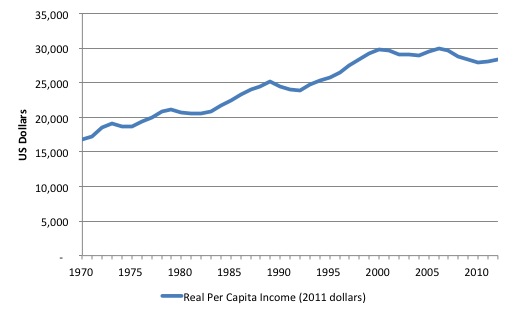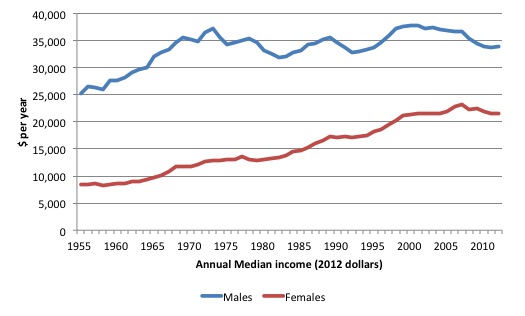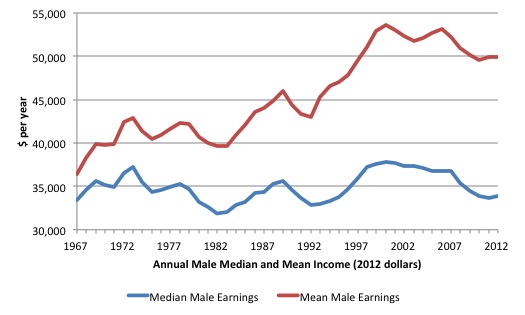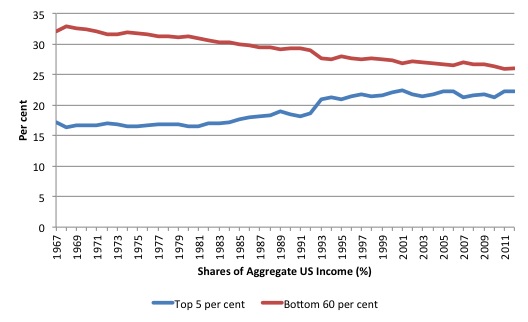I started my undergraduate studies in economics in the late 1970s after starting out as…
161 individuals and their lackeys are the target
There was an UK Guardian article today (September 23, 2013) – The American dream has become a burden for most – which argues that the narratives about the American dream are becoming increasingly recognised as a “delusional myth”. The discussion is relevant for a number of growing research agendas that attempt to construct a new understanding of what has been happening over the neo-liberal period (say, the last 3 decades), how the financial crisis occurred, why it is persisting, who underpins the well-funded campaign against budget deficits as a means of reducing unemployment and redistributing national income towards the bottom of the distribution, and how we might go about reforming/restructuring a global financial order that clearly does not work in the interests of all (make that almost everybody!). One such research agenda is emerging from the field of network analysis and some of the results to date provide a chilling picture of who controls the world financial markets and the governments and central banks that seek to regulate these markets. Essentially, if we want to engage in serious reform we have to unseat the power of some 161 individuals.
The Guardian article is worth considering but is only peripheral to my topic today. It tells us that:
Between 2007 and 2010 the median American family lost a generation of wealth, putting them on a par with where they were in 1992. Last week the census revealed that median household income is roughly the same as it was in 1988 and that the poverty rate had actually increased since 1973. Meanwhile, median male earnings in 2010 were on a par with 1964. This is not for want of effort. American workers continue to make gains in productivity and American companies continue to reap the benefits. Last year corporate profits, as a share of the economy, were the highest since the second world war. The trouble is, none of the benefits went back to them.
And while wages have stagnated and wealth has dissipated, costs have shot up. A family’s health insurance contributions have increased 90% over the past decade. Over the past five years tuition costs have leapt 27% at state universities and 13% at private institutions above inflation. A nation that has long prided itself on being forward-thinking is reconciling itself to going backwards.
I was examining the latest Census Bureau – Historical Data – from the Current Population Survey last week so I thought it was timely that the Press has considered its meaning.
Here are some brief trends in the data that I pulled out.
The following graph shows the movement in Real Per Capita Money Income, All Races (2011 dollars) from 1970 to 2012. The value in 2012 ($US28,281) is equivalent to its value in 1998 ($US,28,304) while the population has grown by 14 per cent over that time.
The following graph shows real Median Income from 1955 to 2012 (2012 dollars) for males and females and highlights the plight noted in the Guardian article.
In 1967, real median income for males was $US33,377 (in 2012 dollars) and in 2012 it was $US33,904. In the same period, productivity has grown substantially, meaning that real income has been transferred away from male workers (and clearly not being offset by gains by female workers).
The stagnation in male real wages is made worse by the rising male joblessness and underemployment.
Mainstream economic theory would seek to explain this trend by suggesting males are now preferring more leisure and less work. However, the evidence is not supportive of that explanation.
There appears to have been no particular social shift towards not working by American males. What we see is a decline in labour demand for male workers in specific segments of the workforce (by education, race, location etc).
The next graph compares the two central measures of the distribution of real male earnings – mean and median – from 1967 to 2012 – and tells us that inequality is on the rise (rather significantly).
Earlier data (which I haven’t had time to patch into the dataset from 1967) shows that the mean and median real earnings rose together throughout the 1950s and 1960s. That was a time when inequality was falling and the middle-class was on the rise (defined here in terms of the central quintiles).
The separation of the time series began in the 1970s and accelerated in the 1980s – I deliberately calibrated the vertical axis to start at $30,000 to show the separation more starkly. If we examined sub-categories – full-time/part-time, employed/unemployed, race, levels of educational attainment etc – the divergence is more extreme.
A 2011 study by Michael Greenstone and Adam Looney published in – The Milken Institute Review (Third Quarter 2011) – concluded that (Page 12):
What appeared as stagnant earnings for workers is really an outright decline in wages for the median men of working age. The me- dian wage of the American male has declined by almost $13,000 after accounting for inflation in the four decades since 1969.
The trends have continued into 2012 and bear on the distribution of income.
US Census Bureau – Historical Data – shows that in 1967, the P90/10 ratio for individual earnings for full-time, year-round workers was 4.20 for males. By 2010 it has risen to 5.5. For women, the corresponding change is from 4.67 to 4.94. The Gini coefficient rose from 0.314 for males to 0.408 in 2010 and 0.298 to 0.357 for females.
Further, the – Shares of Aggregate Income Received by Quintiles – have changed quite dramatically over the last fifty years.
The following graph shows the share of aggregate income received by the Top 5 per cent of the household distribution (blue line) and the bottom 60 per cent since 1967 to 2012.
The rewards of growth are being secured by the top-end-of-town at the expense of the bottom 80 per cent (and the bottom 60 per cent, in particular).
There are many ways of viewing the latest data and I will write more about it in coming weeks once I have a complete story.
But this is why the Guardian article concluded that US polling shows that:
… two-thirds of adults believe their children will enjoy less financial security than they do and face more challenges than opportunities … This lack of confidence in the ability to get ahead is twinned with almost total despair that the political class has neither the means nor the will to reverse the trend … [and] … Both parties supported the financial deregulation and international trade liberalisation that laid the foundations for this despondency.
The article notes that “(l)ittle of this is unique to the US” and wage stagnation and the middle-class squeeze is being felt in most advanced nations.
The relevance to the US is that:
The self-proclaimed leader of the free world is turning into a low-wage economy with a class system more rigid than most and a middle class that wavers between poverty and precariousness … In the absence of a living wage and an ethical pay structure, the work ethic, on which the American dream is founded, doesn’t work.
Which is really a general statement about the evolution of capitalism and the future that should be expected if serious change fails to occur.
The relevance of this discussion relates to other work I have been doing on banking and financial system reform (part of a broader book project which will see the light of day around the end of 2014 at current speed).
There is some excellent research being undertaking on how the financial sector has become concentrated and controlled by a small number of interlinked entities.
For example, an excerpt from a soon to be published book – Fearless Speech in Fateful Times – from – Project Censored – was published yesterday.
The article – Exposing the Financial Core of the Transnational Capitalist Class – by Peter Phillips and Brady Osborne, identifies the:
… people on the boards of directors of the top ten asset management firms and the top ten most centralized corporations in the world … [they find that] … there is a total of thirteen firms, which collectively have 161 directors on their boards … [and] … this group of 161 individuals represents the financial core of the world’s transnational capitalist class. They collectively manage $23.91 trillion in funds and operate in nearly every country in the world. They are the center of the financial capital that powers the global economic system. Western governments and international policy bodies work in the interests of this financial core to protect the free flow of capital investment anywhere in the world.
This study, in fact, used a related 2011 study by Swiss network specialists – – by Stefania Vitali1, James B. Glattfelder1, and Stefano Battiston, published in PLoS ONE, as their starting point.
What did the Swiss study find?
They drilled down into the “web of direct and indirect ownership relations which extends over many countries” to find out who exerted control over the large transnational corporations (TNCs) in finance.
They used “complex network analysis” to accomplish their aim. They posited three alternative hypothesis which might describe the TNC network in the financial sector: (a) TNCs “remain isolated”; (b) TNCs “cluster in separated coalitions”; or (c) TNCs “form a giant connected component, possibly with a core-periphery structure”.
I will leave the explanation of network theory and methods used to those interested.
The study used 43060 TNCs (taken from the Orbis 2007 database, which sampled “30 million economic actors”, that is, shareholders). So a large dataset.
The network identified found the “largest connected component (LCC)” of the structure contained all the “top TNCs by economic value … accounting for 94.2% of the total TNC operating revenue”.
The “strongly connected component or core (SCC)” of the network, which is “a set of firms in which every member owns directly and/or indirectly shares in every other member” accounts for 18.7 per cent of total operating revenue and serves to “weaken market competition”.
It consists of 1347 nodes (that is, a very dominant connected component) and is “very small compared to the other sections of the bow-tie”. The authors consider this a “peculiarity” relative to this type of “bow-tie” network structure. The small core is “very densely connected” and:
As a result, about 3/4 of the ownership of firms in the core remains in the hands of firms of the core itself. In other words, this is a tightly-knit group of corporations that cumulatively hold the majority share of each other.
The latest work from Project Censored “added the top asset management firms from 2012” to the Swiss dataset. They then traced the “people on the boards of directors of the top ten asset management firms and the top ten most centralized corporations” and determined the overlaps.
This reduced the study sample to 13 firms and the 161 individuals who control $23.91 trillion in funds. The next 25 “most valuable asset management firms” control a further $18.8 trillion in funds.
In terms of the concentration of control over the TNCs total value, the study finds “that only 737 top holders accumulate 80% of the control over the value of all TNCs”, which signifies a very concentrated industry sector.
So while the deregulationists invoke mainstream economics textbook ideas about increased competition and the alleged benefits that are expected to flow from that, the reality is that financial market deregulation, which accelerated in the 1980s (at the time, real wages growth started to falter and flatten out (then fall)), has led to an increased concentration of power and a reduction in competition.
The network analysis shows that:
… network control is much more unequally distributed than wealth. In particular, the top ranked actors hold a control ten times bigger than what could be expected based on their wealth.
This control is then structured by the interconnections in the network. The most powerful are at the “core” of the network, which, in turn, “holds collectively a large fraction of the total network control.”
They find that “4/10 of the control over the economic value of TNCs in the world is held, via a complicated web of ownership relations, by a group of 147 TNCs in the core, which has almost full control over itself”.
So policy makers intent on reforming the financial sector actually have a very small group to target, which if they are backed by the voting power of the rest of us (who all have the motivation that we will benefit”, should be a tractable task.
The Swiss study shows that concentrated networks are more prone to “contagion” such that in “bad times firms go into distress simultaneously” thus exposing the World economy to increased risk of financial collapse.
The core players have also shown they will break laws to maintain their control and profit from it.
The former World Bank lawyer – Karen Hudes – who was sacked when sought to blow the whistle on corrupt behaviour within that institution, is now working to expose what she calls a “a small group of corrupt, power-hungry figures centered around the privately owned U.S. Federal Reserve”.
She considers this “network has seized control of the media to cover up its crimes”. She talk about the elaborate system of “state capture … where the institutions of government are co-opted by the group that’s corrupt”.
Not only is the network core made up of private investment banks but the “central banks” have been part of the “power grab”.
The literature that is emerging in this area of study is worth following for it is central to understanding how the financial system has to change to serve the needs of the people.
The most recent study, noted above, which identified the 161 core individual members – notes various characteristics of their background, such as the private universities they attended, etc.
They also identified “(w)ith overlaps … a total of thirteen firms in our study: Barclays PLC, BlackRock Inc., Capital Group Companies Inc., FMR Corporation: Fidelity Worldwide Investment, AXA Group, State Street Corporation, JPMorgan Chase & Co., Legal & General Group PLC (LGIMA), Vanguard Group Inc., UBS AG, Bank of America/Merrill Lynch, Credit Suisse Group AG, and Allianz SE (Owners of PIMCO) PIMCO-Pacific Investment Management Co.” which are controlled by these 161 individuals.
Many of these firms have been prosecuted in the last 5 years for corrupt practices but let off with ridiculously lenient fines. That is, in part, the basis of Karen Hudes’ claims of state capture. The corruption goes right to the heart of the regulative system.
I thought it was significant that the linkages with the government and key multilateral institutions (IMF etc) were strong. For example:
1. 5 of the 13 companies at the core, have “have directors as advisors or former employees of the IMF”.
2. 6 of the 13, “have directors who have worked at or served as advisors to the World Bank”.
3. 5 of the 13 “hold corporate membership in the Council on Foreign Relations in the US”.
4. 7 of the 13 “sent nineteen directors to attend the World Economic Forum in February 2013”.
5. 7 of the 13 “have served or currently serve on a Federal Reserve board, both regionally and nationally in the US”.
6. 6 of the 13 “serve on the Business Roundtable in the US”.
and so it goes.
In other words, attempting to reform the world financial system by banking regulation will fail. There has to be root and branch reform of the IMF, the World Bank, the Bank of International Settlements, the dissolution of central banking systems, and more.
Conclusion
The only way that this sort of reform will start is if the progressive side of politics stops acting like second-rate neo-liberals and starts to build a strong public consensus against these network structures.
The phrase “in union we have strength” has never been more apposite. After all, we only have to knock off 161 individuals! Yes, and all the lackeys they have bought off!
That is enough for today!
(c) Copyright 2013 Bill Mitchell. All Rights Reserved.




Re: The American dream has become a burden for most
In other words, the payoff is always in the future. Or more bluntly, modern capitalism offers a society of jackasses with a stick tied to their heads and a carrot dangling from it.
Very interesting post. I agree our focus should be on money, and who exactly is pulling the strings here. This is what’s missing in our debates between the different political view points (conservatives/progressives) This talk of the roll of money in government that was present the last time we as a nation endured this injustice. During that time around the late 19th century for at least 2 decades coalitions were building around the US that combated this. There seems to be two aspects of money in government. First MMT, how money works in government, and second how those in power use their influence to gain the money needed to keep power. Fighting these things take time, and I do see progress in that there are many coalitions that agree on the basics (get money out of politics) But as I noted earlier the money conversation is missing. Wouldn’t it be great if the professors at UMKC and all advocates of MMT were to join hands with Cooley Law School the proponents of using article V of our constitution and present a two pronged attack against the neoliberals. Many people might say I’m shooting for the stars here and have to step it down a notch. I don’t think so. I agree we’re not going to get financial reform because those in power will not allow it. The only way out is to call a state’s convention and propose amendments to our constitution. Over 80% of our population disagree with the fec vs citizens united decision. Get corruption out of Washington first then we can fix the monetary issue. The funny thing is though, is that I cannot, and do not talk about the state’s right to call a convention to propose amendments to our constitution without in the same breath mention MMT. It goes hand in hand. It’s like telling my friends and neighbors money has too much influence over our elected officials we need to change that, and by the way have you thought about money itself? Patriotism is tied in with article V and even MMT in that we are a sovereign nation issuing our own currency don’t tell me I”m broke! its my money and if I think it’s a good idea to spend it by employing the unemployed than I can do that because I understand how money works in a sovereign country such as ours. I take every opportunity to point people to MMT and articles like yours sir. I’m looking forward to reading your next post